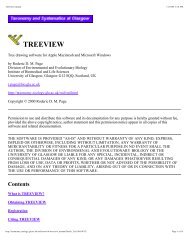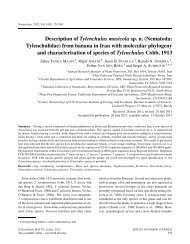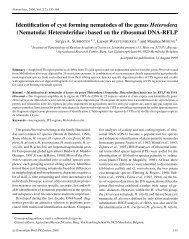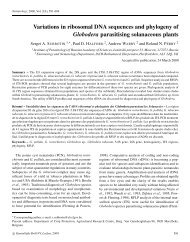Madina Rasulova Molecular Systematics of Nematodes Page 1
Madina Rasulova Molecular Systematics of Nematodes Page 1
Madina Rasulova Molecular Systematics of Nematodes Page 1
You also want an ePaper? Increase the reach of your titles
YUMPU automatically turns print PDFs into web optimized ePapers that Google loves.
It is common to find both sexes <strong>of</strong> sting nematodes in the soil as they reproduce sexually (Fig. 1, B).<br />
After mating the female lays eggs in pairs in the soil until the food is available. Juveniles hatch out <strong>of</strong> eggs<br />
after about five days and try to find a root <strong>of</strong> a plant in order to survive by feeding on it. Juveniles undergo<br />
three moults before becoming adults. The total life cycle <strong>of</strong> Belonolaimus from egg to reproducing adult<br />
takes about 18-24 days. While feeding the nematodes inject enzymes into root tissues and suck plant<br />
juices out via their stylet (Fig. 1, C) killing the meristematic cells which leads to cessation <strong>of</strong> growing <strong>of</strong><br />
root‟s tip (Grosser et al., 2007). This will lead to abnormal formation <strong>of</strong> roots and consequently result in<br />
dramatically decrease <strong>of</strong> harvest.<br />
Due to their significant damage to different crops, measures based on rotation with alfalfa have been<br />
applied and were successful, while chemical nematicides could only reduce the number <strong>of</strong> sting<br />
nematodes (Rau, 1963). That is the main reason why these nematodes were <strong>of</strong> great interest for many<br />
scientists (Rau, 1961; Rau, 1963; Abu-Gharbieh et al., 1970; Cherry et al., 1997; Koenning et al., 2006;<br />
Han et al., 2006; Grosser et al., 2007; Grosser et al., 2007) and more thoroughly studies, both<br />
morphological and molecular, should be conducted in order to understand their evolutionary origination as<br />
well as establish the most efficient method <strong>of</strong> struggle against these economically important pests.<br />
MATERIAL AND METHODS<br />
A partial nucleotide sequence <strong>of</strong> unknown Belonolaimus genus was chosen for the project work for<br />
further analyzing using different molecular and phylogeny programs. The first step was to find out the<br />
species <strong>of</strong> this genus as well as the type <strong>of</strong> this given sequence in NCBI GenBank by BLAST <strong>of</strong><br />
nucleotides (Appendix, Figure 4).<br />
According to NCBI GenBank, the studied gene was complete sequence <strong>of</strong> ITS1 region as well as<br />
contained other partial parts in both ends. Two ITS regions <strong>of</strong> rDNA, which are located between 18S SSU<br />
and 5.8S for ITS1 and 5.8S and 28S LSU for ITS2, are particularly well-suited for species and population<br />
<strong>Madina</strong> <strong>Rasulova</strong> <strong>Molecular</strong> <strong>Systematics</strong> <strong>of</strong> <strong>Nematodes</strong> <strong>Page</strong> 4
















